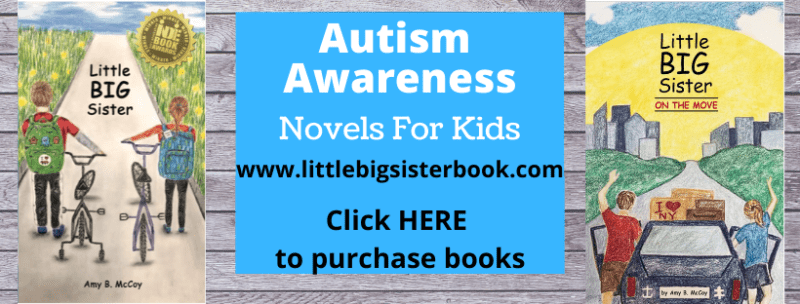Typically developing siblings of individuals with autism spectrum disorders (ASD) have a unique set of needs that often go overlooked and unnoticed. These needs are generally social and emotional in nature and can affect siblings at any age during their lifespan. When one family member has a disability, it affects the whole family because family members may feel isolated from others or different because of the impact of the disability (Burke, 2004)

Amy B. McCoy, MS Ed
Main Causes of Sibling Difficulties
Lack of communication and information – Many siblings are not given the name or definition of their sibling’s disability. When siblings have a limited understanding of their sibling’s condition, this lack of information may lead to distortion and confusion (Kahn & Lewis, 1988). Some may wonder if they caused their sibling’s autism or if it is contagious. As they get older, they may wonder if they will become responsible for their sibling’s care after their parents are no longer able to care for his or her needs. Having an open line of communication between parents, siblings and other family members about autism alleviates this struggle. Siblings need more information about autism not only for their own understanding, but also to make it easier for them to explain to others why their brother or sister with ASD behaves differently (Abrams, 2009).
Lack of Support – Siblings may feel isolated and unaware that they are not the only one who has a sibling with ASD. Many siblings feel disconnected from their peers because peers can’t understand the complexity of their relationship with their sibling who has ASD. Social support specifically for siblings may play an important role in the healthy and adaptive adjustment of siblings (Kaminsky & Dewey, 2002). Support groups for siblings help to counter feelings of isolation by enabling siblings to identify that others are dealing with similar circumstances (Abrams, 2009).
Feelings of Resentment, Embarrassment and Frustration – Some siblings have reported feelings of resentment because of the extra parental attention given to their sibling with autism (Benderix & Sivberg, 2007). From the moment of an ASD diagnosis, (and often before), parents are propelled into a world of therapies, special education meetings, medical appointments and other time-consuming elements of the ASD experience. While every family is different, it is inevitable that parents’ time, energy and attention becomes focused disproportionally on their child with ASD. Some siblings feel embarrassed by their sibling’s behavior and as a result do not invite friends over to their homes (Abrams, 2009). Many siblings have reported feelings of frustration and even grief over the loss of a typical sibling relationship. They may also experience frustration over witnessing or being a target of aggressive behaviors by their sibling with ASD.
Supporting the Unique Needs of Super Siblings – Tips for Families
Honest, Age Appropriate and Ongoing Communication – Keep the conversation about autism open and ongoing, as the siblings’ need for information and the extent of details will change as he/she matures. Providing age appropriate explanations for what autism is can help siblings understand and manage their perceptions about why their sibling with ASD receives extra attention and support (Harris and Glasberg 2003). It is important that the sibling can share his or her feelings, both positive and negative with parents or others (Benderix & Sivberg, 2007). If the child is not comfortable sharing thoughts and feelings verbally, use of a two-way journal, where parent and child alternate written entries may be helpful. Reading children’s books that include characters with ASD together may spark an open, honest, ongoing conversation about ASD.
Support Groups – You Are Not Alone – One well documented program for supporting siblings is Sibshops. Siblings who attend Sibshops show an increase in positive feelings about their brother or sister with a disability and acquire useful coping strategies (Johnson & Sandall 2005). If there are not any support group opportunities in your area, connect with other families through your child’s school or through special needs recreational sport programs. Locate babysitters or caretakers who are siblings of individuals with ASD so your younger child has access to a role model who is living in this situation.
One-on-One Time, Making Socializing Possible, Acknowledging Strong Emotions – To counter the feelings of resentment caused by extra parental attention focused on the child with ASD, parents can schedule one-on-one time with their typically developing child(ren). Just 20 minutes per day of undivided attention engaging in your child’s choice of activity makes a meaningful difference.
To make socializing possible, arrange for a caretaker to bring your child with ASD out for a few hours so your other child can invite a friend over. If that is not possible, the caretaker can stay in your home while you take your typical child out with a friend to the park, a movie, a restaurant or any location that is appealing to your child.
When siblings are able to express their strong feelings (of frustration, anger, sadness or any other feelings related to their sibling with ASD) parents can acknowledge these feelings without judgment. “I noticed you are feeling angry about your brother,” is a response that allows the expression of strong feelings. Identifying and allowing the strong feelings helps siblings to process their emotions and feel understood.
Summary
Siblings of individuals with ASD have specific and unique needs. Keeping communication open, honest and ongoing is a key component when supporting siblings. Providing siblings with opportunities to meet other siblings of individuals with ASD is beneficial in order to decrease feelings of isolation. Planning one on one time with our typically developing children and arranging creative ways for them to socialize comfortably with peers are two approaches that parents can take to support these specific needs. Acknowledging and allowing siblings to express strong emotions helps them to process their emotions and feel better supported.
Amy B. McCoy is a former elementary school teacher and disability educator and current children’s book author. She writes the Little Big Sister book series which focuses on autism awareness, told from a sibling’s point of view. She is a visiting author to elementary schools spreading autism awareness and understanding. For more information please visit www.littlebigsisterbook.com.
References
Abrams, M. (2009). The well sibling: Challenges and possibilities. American Journal of Psychotherapy, 63, 311.
Benderix, Y., & Sivberg, B. (2007). Siblings’ experiences of having a brother or sister with autism and mental retardation: A case study of 14 siblings from five families. Journal of Pediatric Nursing, 22, 411-417.
Burke, P. (2004). Brothers and sisters of disabled children. Jessica Kingsley Publishers.
Harris, S., & Glasberg, B. (2003). Siblings of children with autism: A guide for families (2nd ed.). Woodbine House.
Johnson, A.B., & Dewey, D. (2005). Sibshops: A follow-up of participants of a sibling support program. University of Washington.
Kahn, M.D., & Lewis, K.G. (1988). Siblings in therapy: Life span and clinical issues. W.W. Norton and Company.
Kaminsky, L., & Dewey, D. (2002). Psychosocial adjustment in siblings of children with autism. Association for Child Psychology and Psychiatry. 43, 231.





